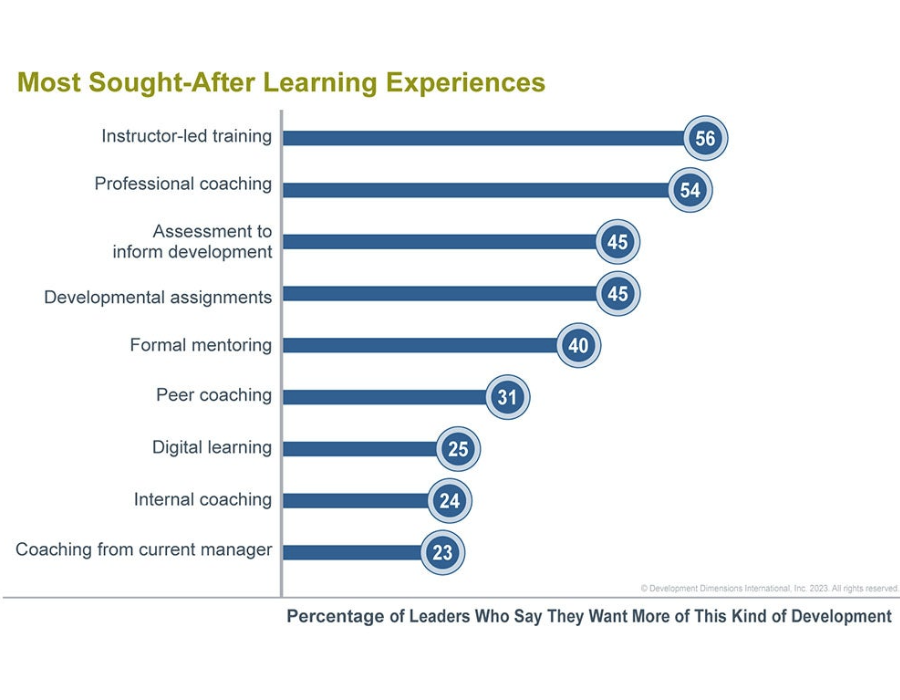HR professionals are under a lot of pressure to prove that leadership development programs have a return on investment. When leaders’ time is precious and financial resources are limited, how do organizations get the most out of their programs? One way is to focus on the difference between learning and development. But what is the difference between learning and development?
Learning is defined as gaining new knowledge. Development is applying that knowledge to drive results and grow. When it comes to leadership, we simply can’t afford to build programs where leaders are learning but not developing.
What is the difference between learning and development? And how does it show up in your organization? For starters, if your leaders are learning but not developing, you might see one or more of the following:

1. The organization relies too much on self-directed learning.
It’s common to hear that leaders should own their development. Yes, it’s true that leaders should fully participate in development and try to apply what they’ve learned to get better. What this doesn’t mean is that we should only rely on self-directed learning.
Many organizations invest in huge online libraries of learning content. They promote them to leaders as a “one-stop shop” for building leadership skills on demand. Sounds great, right? And as an added bonus, this content is often high quality and presented in a compelling way.
Unfortunately, this "build it and they will come" strategy doesn’t provide the same benefits as a more coordinated leadership development program. But what does a more coordinated program have? Leaders can also practice skills in a safe environment and socialize new behaviors while working with their peers.
Lately, leaders have been asking for more development experiences with a social component. In the era of virtual and hybrid work, leaders feel more isolated from their peers. According to DDI’s recent Global Leadership Forecast, their most desired development experience is instructor-led training. Meanwhile, self-paced digital learning is near the bottom of the list of preferred learning methods.


2. Leaders participate in programs but don’t change and grow.
Learning only becomes development when it’s applied on the job. When leaders go to training programs but don’t change their behavior, they may have learned, but they certainly haven’t developed.
And the cause of this lack of change and growth? It’s often a shortage of self-insight. Resources like 360 feedback tools and simulation-based assessments uncover blind spots. These resources also do a good job of showing leaders why they need to change and how they can do it. In addition, with the data and insights these tools provide, leaders become more committed to making a change.
Leaders also have a hard time changing when they feel their employee development isn’t connected to the organization’s business or cultural priorities. If the same learning programs have been in place for years despite significant changes to the organization, leaders may see the programs as outdated, irrelevant, or a mere formality. But how do top organizations avoid this? Regular leadership needs analyses are a good place to start. It can also be helpful for organizations to align development offerings with the challenges their leaders are facing today.
One way to think of the difference between learning and development is to ask yourself, “What are the top concerns leaders have in their current business context?” If turnover rates are through the roof, your program needs to build the skills to address that. If your company is going through a merger or acquisition, your leadership programs should provide leaders skills to navigate a more complex stakeholder environment and lead through change. If leaders are struggling to adapt to leading remote or hybrid teams, leadership programs should help them level up on team chartering, leading virtually, and creating a healthy remote work culture.

3. Learning is episodic and lacks “connective tissue.”
When learning is event-based and not part of a bigger development experience, it’s hard to build the momentum for meaningful leadership development. Leaders may have a desire to make the most of leadership development opportunities, but ultimately, they need guidance and direction to do it. As a leadership development professional, your job is to create that structure, accountability, and engagement.
For this reason, many organizations have adopted a learning journey approach. This approach treats development as behavior change that takes place over time. Leaders achieve behavior change through a focused mix of formal learning, one-on-one coaching, assessment, and online reinforcement tools (like job aids, microcourses, chatbots, and practice simulations). In a learning journey, leaders are given a road map for development as well as all the ways they can apply their learning on the job.
DDI research on the impact of learning journeys shows that organizations that adopt this approach are 3.4X more likely to have high-caliber leadership development. These organizations are also 2.9X more likely to have high leadership strength and 2.5X more likely to be financially successful.

4. Learners don’t have support from their leaders.
Learners have the best opportunity to develop when their own leader supports them with coaching. In this environment, learning is the means to better performance, but not the end. For learning to become development, the learner’s leader must challenge them to apply new skills and provide meaningful feedback.
Some well-meaning managers may send struggling leaders to training programs so that “HR can fix them.” While someone struggling with their leadership skills should certainly participate in leadership development, relying on HR to fix performance issues is a sign that the leader’s leader could play a more active role in their development.
What Development Has That Learning Doesn’t
Leaders today face unprecedented challenges, pace of change, and pressure to achieve results. There isn’t time or energy for learning for learning’s sake.
So what is the difference between learning and development? The ultimate difference is this: Learning can give leaders new skills, while development can help leaders solve the problems they face. Development inspires leaders to take on the challenges of leadership, armed with the right behaviors.
Learn best practices for how to implement a leadership development program.
Mark Smedley is a Leadership Advisor for DDI. He is passionate about helping organizations hire the best leaders, build their leadership bench strength, and make leadership development a way of work in a fast-paced world. Follow Mark on LinkedIn where he talks about the modern workplace, the human side of leadership, and perspectives on diversity, equity, inclusion, and belonging.
Topics covered in this blog

